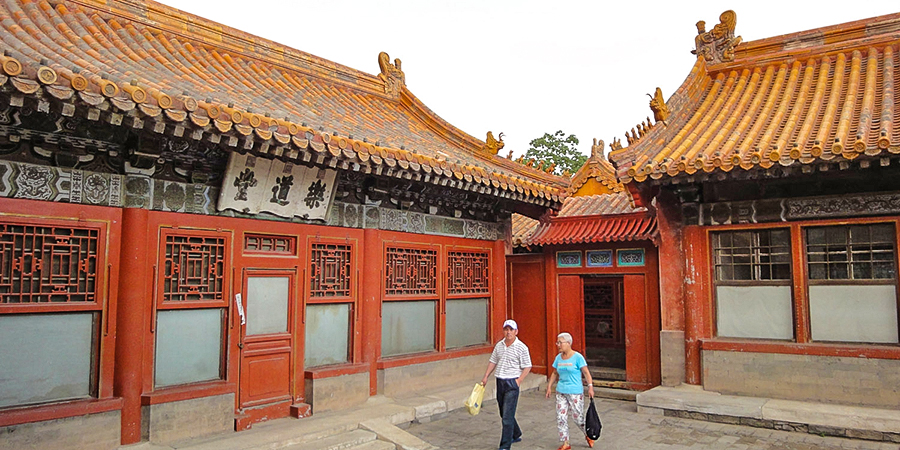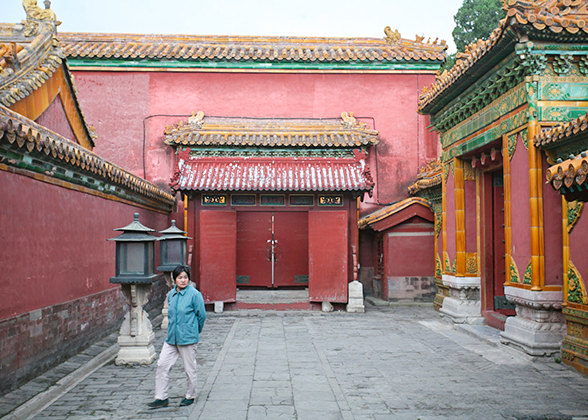Originally built in the 18
th year of reign of emperor Yongle in 1420, and named Shou’angong, Palace of Universal Happiness (Xianfugong) belongs to one of Six Western Palaces in inner court of
Forbidden City. In the 14th year of reign of Jiajing in 1535, the palace was renamed Xianfugong. In the 22nd year of the reign of emperor Kangxi in 1683, and in the 23rd year of the reign of
emperor Guangxu in 1897, it was repaired and refurnished. The existing buildings are in good condition for sightseeing when you come to Forbidden City.
What to See inside the Palace of Universal Happiness (Xianfugong)
Xianfugong has two courtyards. The main hall in the front yard is for reception and ceremony and the back hall in the back yard is bedroom.
Front Yard
The main hall, also named “Xianfugong”, has 3 rooms, different from other 5 palaces in Six Western Palaces whose main halls have 5 rooms. But this layout is the same as the Jingyanggong of Six Eastern Palaces. Actually, the two palaces are symmetrical on the central axis of the Forbidden City. The reason why Xianfugong’s main hall has only rooms was not recorded in the historical records. Some people say that it is because of Feng shui, while others say that it is the residence for the lower status concubines since the palace is located at the most remote corner in Six Western Palaces. The main hall is also attached with 3 side rooms on both east and west sides, like other 5 western palaces.
Back Yard
The back hall in the backyard is called “Tongdaotang” with 5 rooms. There is a Guqin, a plucked seven-string Chinese musical instrument hidden in the east chamber. The west room has many collections including many paintings. Tongdaotang also has the east and west side halls. In the southeast of the backyard there is a well under a pavilion. The
empress dowager Cixi once lived here when she was still an ordinary concubine. Among the two seals left by emperor Xianfeng to Ci’an and Cixi, the one for Cixi was called Tongdaotang. The inscription "Ke Jing Ju" (refrain and respect) written by emperor Xianfeng is hung in Tongdaotang. Whenever empress dowager Cixi needed to make a decision on important issues, she would come here to look at the plaque and think twice.
Who else had ever lived in Palace of Universal Happiness (Xianfugong)?
Xianfugong is the residence of the concubines. But there were also emperors who once lived here.
Ming Noble Concubine Jing (? - 1597)
She is the concubine of emperor Wanli and is beloved second only to concubine Zheng at that time. Concubine Jing lived in Xianfugong all her life.
Noble Concubine Zhuangshun (1822 - 1866), Noble Concubine Tong (1817 - 1875), Noble Concubine Cheng ( 1813 - 1888), and Concubine Chang (1818 - 1860).
Qing Emperor Qianlong (1711 - 1799)
During the reign of emperor Qianlong, Palace of Universal Happiness became an occasional residence for the emperor.
Qing Emperor Jiaqing (1760 - 1820)
In the fourth year of reign of Jiaqing in 1799, emperor Qianlong died in January. Later, emperor Jiaqing lived in Xianfugong to mourn his father and show filial piety. He ordered not to set up a bed, only spread with white felt, light mattress and other items as a bed. The emperor Jiaqing lived here till October of that year, then moved to Yangxindian.
Emperor Xianfeng (1831 - 1861)
In 1850 after the emperor Daoguang passed away, emperor Xianfeng lived in Xianfugong to mourn his father. After that, he still lived here from time to time.
See more Six Western Palaces
- Last updated on Sep. 26, 2024 by Gabby Li -

